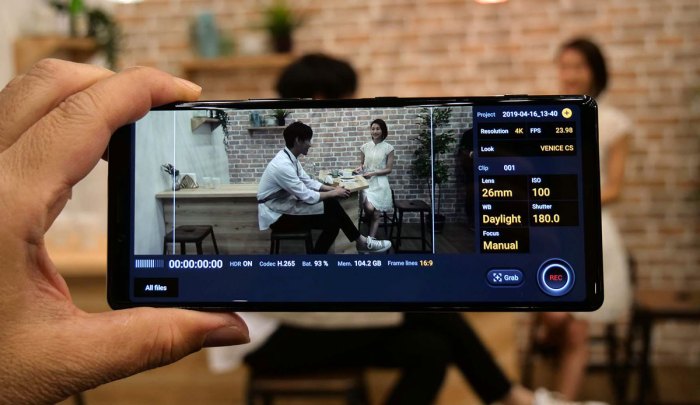The best videography smartphone isn’t just about having a good camera; it’s about a harmonious blend of features that empower you to capture stunning footage and tell compelling stories. From the size of the sensor and the quality of the lens to the video recording capabilities and the power of the editing software, each element plays a crucial role in creating a smartphone that truly excels in videography.
This guide delves into the key factors to consider when choosing the best videography smartphone for your needs. We’ll explore everything from camera features and video recording capabilities to software, battery life, and even user experience and design. By the end, you’ll have a comprehensive understanding of what to look for in a smartphone designed to elevate your videography game.
Smartphone Camera Features
The camera is a crucial aspect of any smartphone, and understanding its features is essential for capturing high-quality photos and videos. Let’s delve into the key components that contribute to a great smartphone camera experience.
Sensor Size
The size of the sensor is a critical factor influencing the quality of images captured. A larger sensor allows for more light to be captured, resulting in better low-light performance and richer detail. Larger sensors also enable the capture of a wider dynamic range, which refers to the difference between the brightest and darkest areas of an image. This translates to more detail in both highlights and shadows. For instance, a 1/2.55-inch sensor is significantly larger than a 1/3.6-inch sensor, resulting in a noticeable improvement in image quality.
Aperture
The aperture of a lens determines the amount of light that enters the camera. A wider aperture, represented by a lower f-number (e.g., f/1.8), allows for more light to pass through, enhancing low-light performance and creating a shallower depth of field. A shallower depth of field results in a blurred background, emphasizing the subject and creating a more pleasing aesthetic. A wider aperture also contributes to a faster shutter speed, allowing for better capture of fast-moving subjects.
Lens Configurations
Different lens configurations offer distinct perspectives and capabilities.
- Wide-angle lenses provide a broader field of view, ideal for capturing landscapes or large groups of people. They can also be useful for capturing architectural details and creating a sense of space.
- Telephoto lenses, on the other hand, offer a narrower field of view, allowing for closer shots of distant subjects. This is particularly useful for capturing wildlife, sports events, or portraits where you want to isolate the subject from the background.
- Macro lenses are specialized lenses designed for capturing close-up shots of small objects. They offer high magnification and a shallow depth of field, enabling you to capture intricate details that are often overlooked.
Optical Image Stabilization (OIS)
Optical image stabilization (OIS) is a technology that helps reduce camera shake, resulting in sharper and more stable videos. OIS works by using a sensor that moves in the opposite direction of the camera shake, effectively canceling out the movement and creating smoother footage. This is particularly beneficial for capturing videos while walking, running, or in other situations where hand movements are inevitable.
Autofocus Technology, Best videography smartphone
Autofocus technology plays a crucial role in ensuring sharp and focused videos. Smartphones employ various autofocus systems, such as phase detection autofocus (PDAF) and contrast detection autofocus (CDAF). PDAF is known for its speed and accuracy, while CDAF offers a wider focus range. The autofocus system continuously adjusts the lens to ensure the subject remains in focus, even when it’s moving.
User Experience and Design: Best Videography Smartphone
When it comes to choosing the best videography smartphone, user experience and design are critical factors that shouldn’t be overlooked. A comfortable and intuitive design can significantly enhance your video recording experience, making it more enjoyable and productive.
Smartphone Size and Weight
The size and weight of a smartphone can have a significant impact on how comfortable it is to hold and use for extended periods, especially when recording videos.
- Smaller smartphones, typically with screens under 6 inches, are generally more comfortable to hold and use for extended periods, especially with one hand. They are also lighter, which can be a significant advantage if you plan to use your phone for recording videos on the go.
- Larger smartphones, with screens exceeding 6 inches, offer a more immersive viewing experience, which can be beneficial for video editing and playback. However, they can be bulkier and heavier, making them less comfortable to hold for extended periods.
Final Conclusion
Ultimately, the best videography smartphone for you will depend on your specific needs and priorities. Whether you’re a casual videographer looking for a phone that can capture high-quality footage for social media or a more serious filmmaker who demands professional-level features, there’s a smartphone out there that can meet your expectations. By carefully considering the factors Artikeld in this guide, you can confidently choose a device that will empower you to create captivating videos and share your stories with the world.
Choosing the best videography smartphone often involves considering factors like camera quality, stabilization, and processing power. However, it’s also important to think about how the phone will handle the heat generated during long recording sessions. A good option is to invest in a cooling smartphone accessory to prevent overheating and ensure smooth, uninterrupted recording.
This will allow you to capture the best possible footage, regardless of the duration of your video project.
 Informatif Berita Informatif Terbaru
Informatif Berita Informatif Terbaru
